Introduction
In a world where industries evolve rapidly and job requirements change overnight, traditional learning models are struggling to keep up. Rote memorization and purely theoretical lessons no longer meet the demands of modern learners and professionals. To bridge this gap, an innovative methodology called Duaction has emerged.
Derived from the fusion of the words “dual” and “action,” Duaction emphasizes the simultaneous development of theoretical knowledge and its immediate practical application. Unlike conventional learning approaches where knowledge is absorbed first and applied much later, Duaction brings both elements together in real-time. This makes it a powerful tool for education, skill development, and professional training.
In this article, we will explore what Duaction is, how it works, its advantages, challenges, and its potential to transform education and workforce training in the 21st century.
What is Duaction?
At its core, Duaction is a modern concept of learning that integrates theory and practice simultaneously. Rather than teaching learners abstract principles in isolation, Duaction ensures that every concept is immediately tied to real-world application.
For example, in a classroom or training environment, a student might learn about business negotiation strategies and then instantly role-play a scenario to apply those strategies. Similarly, a programming student might learn a coding concept and directly build a functional prototype instead of just reading about syntax.
The principle is simple: learn by doing, and do while learning.
Origins and Relevance
The Duaction model was inspired by the growing demand for hands-on learning experiences in both academic and professional environments. Traditional systems often separate theory and practice by years—students may study economics for three years before ever applying it in the real world. Duaction seeks to collapse that timeline.
Its relevance is especially high today because:
- Employers seek job-ready candidates. Companies want employees who can apply skills immediately without lengthy onboarding.
- Technology evolves fast. Learners can no longer afford to delay application while knowledge becomes outdated.
- Engagement is critical. Research shows that learners retain more knowledge when they practice concepts instantly.
Key Principles
Duaction is guided by a set of core principles that differentiate it from conventional education models:
- Simultaneity – Knowledge and practice occur together, reducing the gap between theory and application.
- Contextualization – Lessons are always tied to real-world examples, case studies, or simulations.
- Active Participation – Learners are not passive recipients; they are active doers.
- Feedback Loops – Immediate feedback ensures mistakes become part of the learning process.
- Adaptability – The methodology can be applied in schools, corporate training, vocational education, and even self-learning.
How Duaction Works in Practice
Duaction is not restricted to classrooms; it can be implemented across various learning environments:
1. In Schools and Universities
- Science students might learn about Newton’s laws and immediately conduct experiments that prove the principles.
- Medical students could study anatomy and perform simulations on virtual patients at the same time.
2. In Corporate Training
- Employees might attend a workshop on leadership skills and simultaneously role-play managing a conflict scenario.
- Technical teams can learn about cybersecurity concepts while running penetration tests on mock systems.
3. In Online Learning
- Platforms can integrate real-time projects, coding sandboxes, or virtual labs.
- Learners gain certificates based on demonstrable projects, not just quiz scores.
4. In Everyday Life
- Language learners practice conversational skills as they acquire new vocabulary.
- Entrepreneurs test small business ideas while learning about market theories.
You Might Also Like : Barchart Coffee
Benefits of Duaction
Duaction brings several advantages that make it a superior methodology in many contexts.
1. Improved Retention
Learners retain more information when they apply it instantly. The act of doing cements theoretical knowledge.
2. Job-Readiness
Graduates and trainees equipped with Duaction skills enter the workforce with practical experience, making them highly employable.
3. Engagement and Motivation
Active participation keeps learners more engaged than passive listening or reading.
4. Critical Thinking and Problem-Solving
By engaging with real-world problems during learning, students develop sharper analytical skills.
5. Bridging the Skill Gap
Many industries face a shortage of skilled workers. Duaction shortens the time needed for learners to become proficient.
Duaction vs. Traditional Learning
| Aspect | Traditional Learning | Duaction |
| Approach | Theory first, practice later | Theory + practice together |
| Student Role | Passive listener | Active participant |
| Retention | Lower due to delayed application | Higher through immediate use |
| Relevance | Often abstract | Directly connected to real-world |
| Adaptability | Limited to classroom | Applicable in schools, training, and online |
Real-World Applications of Duaction
1. STEM Education
Science, Technology, Engineering, and Mathematics (STEM) thrive under Duaction. For instance, engineering students can learn structural theory and simultaneously design 3D models.
2. Medical Training
Medical schools can integrate VR simulations, allowing students to practice surgical techniques while learning anatomy.
3. Business and Entrepreneurship
Students can design business plans, launch pilot projects, and test theories of finance or marketing in real time.
4. Corporate Upskilling
Companies adopting Duaction improve efficiency by giving employees practical training while introducing new concepts.
5. Digital Learning Platforms
EdTech companies are increasingly offering Duaction-based courses where learners apply skills through capstone projects.
Challenges of Implementing Duaction
While powerful, Duaction does come with challenges:
- Resource-Intensive – Requires tools, labs, and facilitators for effective practice.
- Time Constraints – Designing dual learning sessions may take longer than traditional lectures.
- Assessment Difficulties – Evaluating both theoretical understanding and practical application can be complex.
- Resistance to Change – Traditional institutions may hesitate to adopt new methodologies.
- Scalability Issues – Implementing Duaction in large classrooms or organizations requires innovation in delivery methods.
Strategies for Successful Duaction Implementation
- Blended Learning Models – Combine online simulations with offline practice to maximize reach.
- Project-Based Learning – Design courses around real-world projects instead of abstract lessons.
- Technology Integration – Use AR/VR, coding labs, and collaboration platforms to enable practice.
- Mentorship Programs – Pair learners with industry mentors for real-time application.
- Continuous Feedback – Build assessment tools that track both progress and applied skills.
Future of Duaction
The future of education is experiential, immediate, and adaptable—all of which align with Duaction. As industries adopt AI, automation, and digital tools, the workforce needs adaptable learners who can both understand theory and act on it instantly.
- In education, Duaction will reshape curricula, ensuring students are workforce-ready.
- In corporate environments, it will become the standard for upskilling employees.
- In personal development, learners will embrace Duaction for hobbies, freelancing, and entrepreneurship.
Ultimately, Duaction has the potential to become a global learning standard, bridging the gap between knowledge and execution.
Conclusion
Duaction is more than a learning method—it’s a mindset shift. By merging theoretical learning with immediate practice, it empowers learners to master skills faster, retain knowledge longer, and apply insights effectively in real life. While challenges exist in implementation, the benefits far outweigh the obstacles.
In a fast-changing world where adaptability is the ultimate skill, Duaction is not just the future of learning—it is the present reality that will shape tomorrow’s innovators, professionals, and leaders.

